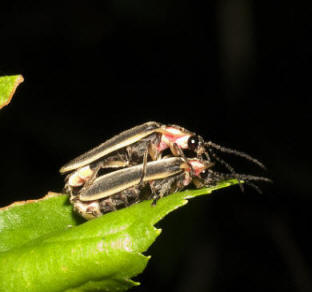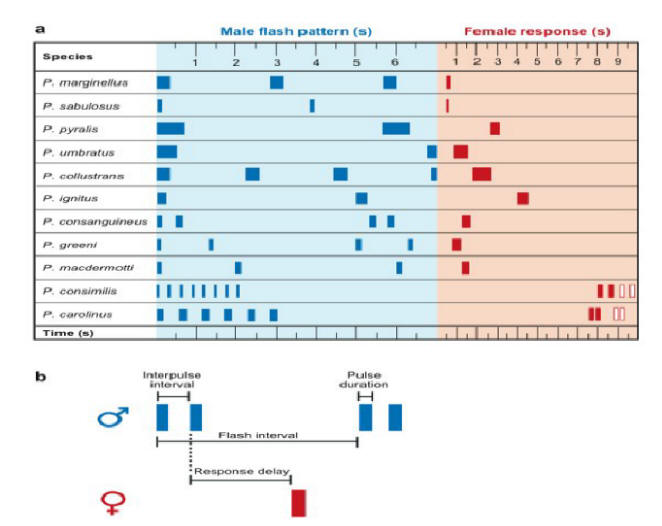Life History & Reproduction
Like all beetles, Photinus ignitus
and all other fireflies undergo an indirect life cycle of four life
stages: egg, larva, pupa, and adult (Lloyd, 2005). The egg, or
embryonic stage, is where the firefly life cycle begins. A
fertilized female will deposit her eggs in the soil around
mid-summer. Photinus ignitus have a preference for
moist soils, so the most common place for their eggs will be under
mulch (Debbie, 2013). To learn more about the environment that
Photinus ignitus lives in check out
Habitat and Geography. The worm-like hunting and eating
specialist indicate the next stage of the firefly life cycle: larval
stage. Larvae are predaceous, and at night, they will hunt
soft-bodied prey, such as slugs, snails, worms, and other insects.
Photinus ignitus are especially apt to target annelids (segmented
worms) while scavenging for food (Lloyd, 2005). Upon capture
of the prey, the firefly larva will inject digestive enzymes that
will immobilize and break down the remaining kill (Debbie, 2013).
Some snails that live in the same environment as Photinus ignitus
are
Stenotrema exodon and
Stenotrema barbatum. Even though in a different
environment, here are a couple more interesting snails that could be
prey for other species of fireflies,
Praticolella candida and
Praticolella trimatris.
Glow worm larva eating a snail from Robin Scagell.
Larvae, also called
glowworms, have a defensive mechanism of being luminescent.
The larvae glow to indicate to predators of an unpalatable, or
unpleasant, taste. They may even have lethal consequences to
the predators who are not warned off (Lloyd, 2005). To learn
more about this, visit the
Interactions page. In the
next stage of the firefly, we examine a remarkable transformation.
The pupal stage usually takes place in late spring, where the larvae
seek or make sheltered places (Debbie, 2013). Photinus larvae
usually pupate in self-made chambers under the surface of the soil.
Pupation lasts from one to three weeks (Debbie, 2013), where the
larva’s body is broken down by biochemical processes and transformed
into an adult firefly (Lloyd, 2005). An estimated 10 days to
several weeks after the completion of metamorphosis, the adult
firefly is ready to emerge. The adult firefly is generally
only concerned with finding a mate and reproducing (Lloyd, 2005).
The way in which fireflies find mates and reproduce is quite
fascinating. Fireflies, in general, have a diverse form of
courtship signals. The way in which the males find the females
is very different depending on what part of the day the firefly is
active. The fireflies that are active during the day detect
where the female is by the females’ pheromone, which is a volatile
chemical signal that leads the male upwind toward the signal source,
the female (Lloyd, 2005). Photinus ignitus is a nocturnally
active firefly. Instead of using pheromones for their
long-range attraction, these fireflies use discrete pulses of
bioluminescence to locate their mates (Lewis & Cratsley, 2008).
In some species, only the flightless female will emit flash signals
to attract the
 male, but in
Photinus ignitus, both species produce
bioluminescent glows (Lewis & Cratsley, 2008). To increase the
complexity of finding mates, the flash signals emitted from both
sexes are precisely timed to encode what species the lightning bug
is and also whether it is male or female. In some species
there is just a single flash of bioluminescence, but in Photinus
ignitus it is a group of flashes (Lloyd, 2005). After the
female locates a male of her species producing bioluminescent
courtship flashes with his lantern, the female will respond from her
perched location with a flashing of her own after a critical
species-specific time delay (Cratsley & Lewis, 2005). This
courtship dialogue will continue back and forth until the male, who
is flying, walking and climbing towards the destination, makes
contact with the female (Lewis & Cratsley, 2008). The
male, but in
Photinus ignitus, both species produce
bioluminescent glows (Lewis & Cratsley, 2008). To increase the
complexity of finding mates, the flash signals emitted from both
sexes are precisely timed to encode what species the lightning bug
is and also whether it is male or female. In some species
there is just a single flash of bioluminescence, but in Photinus
ignitus it is a group of flashes (Lloyd, 2005). After the
female locates a male of her species producing bioluminescent
courtship flashes with his lantern, the female will respond from her
perched location with a flashing of her own after a critical
species-specific time delay (Cratsley & Lewis, 2005). This
courtship dialogue will continue back and forth until the male, who
is flying, walking and climbing towards the destination, makes
contact with the female (Lewis & Cratsley, 2008). The flashing will cease after the male mounts the female dorsally.
Copulation (sexual intercourse) occurs once the male firefly inserts
his aedeagus (male reproductive organ) into the female’s genital
opening (Cratsley & Lewis, 2005). This is the first of two
stages of mating. Stage two occurs once the male rotates 180°,
remaining abdomen-to-abdomen with the female. The male then
transfers a spermatophore (a sperm-containing package) into the
female’s bursa. This stage is quite long, lasting up to 8
hours (Cratsley & Lewis, 2005).
flashing will cease after the male mounts the female dorsally.
Copulation (sexual intercourse) occurs once the male firefly inserts
his aedeagus (male reproductive organ) into the female’s genital
opening (Cratsley & Lewis, 2005). This is the first of two
stages of mating. Stage two occurs once the male rotates 180°,
remaining abdomen-to-abdomen with the female. The male then
transfers a spermatophore (a sperm-containing package) into the
female’s bursa. This stage is quite long, lasting up to 8
hours (Cratsley & Lewis, 2005).
Back to
Home
Read about
Interactions

